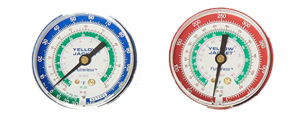
Summary of Knowledge Required for CORE Examination
Environmental Impact and Consequence:
- Knowledge of atmospheric ozone destruction by chlorine.
- Knowledge of the presence of chlorine in certain refrigerants, namely CFC (chloroflourocarbon) refrigerants and HCFC (hydrocloroflourocarbon) refrigerants.
- Ability to identify CFC, HCFC, and HFC (hydrofluorocarbon) refrigerants. Not by their chemical formulas but simply that R-12 is a CFC (chloroflourocarbon) refrigerant, R-22 is a HCFC (hydrocloroflourocarbon) refrigerant, and R-134 is a HFC (hydrofluorocarbon) refrigerant, etc.
- Knowledge of what ozone-depletion potential (ODP) is.
- Knowledge that a CFC refrigerant has a higher ozone-depletion potential (ODP) than an HCFC refrigerant, and that they in turn have a higher ODP than HFC refrigerants..
- Have an understanding of the effects that different types of refrigerants have upon the atmosphere.
- Knowledge of the negative health and environmental effects from ozone depletion in the stratospheric layer of the atmosphere.
- Knowledge there is evidence of stratospheric ozone depletion and the role that CFC and HCFC refrigerants have played in that depletion.
The Clean Air Act and Montreal Protocol:
- Knowledge of the CFC phaseout date.
- Knowledge of the R-22 refrigerant phaseout date. (R-22 is an HCFC)
- Knowledge that venting refrigerants into the atmosphere while servicing appliances is prohibited.
- Knowledge that venting substitute refrigerants is prohibited also.
- Knowledge of the maximum penalty that can be issued under the Clean Air Act.
- Knowledge of the Montreal Protocol which is an international agreement to phase out the production of ozone-depleting substances.
EPA Section 608 Regulations:
- Ability to define and identify high-pressure and low-pressure refrigerants.
- Be able to define “system-dependent” recovery/recycling equipment and “self-contained” recovery/recycling equipment.
- Be able to identify all air-conditioning and refrigeration equipment covered by the EPA 608 rule. (Except motor vehicle air-conditioners)
- Know that there is a requirement in the 608 rule that equipment used for recycling and recovery needs to be certified by a third-party organization.
- Knowledge of the standard for reclaimed refrigerants. (AHRI Standard 700-2016)
- Knowledge that the 608 places sales restrictions on refrigerants.
- Knowledge that the 608 regulation bases its venting restrictions on The Clean Air Act.
Using Substitute Refrigerants and Oils:
- Knowledge of the incompatibility that substitute refrigerants have with many of the lubricants used in systems containing CFC and HCFC refrigerants and likewise having the knowledge of the incompatibility of CFC and HCFC refrigerants with many of the new lubricants. Your knowledge must include identification of lubricants being suitable for use with given refrigerants, such as esters with R-134, alkylbenzenes with HCFCs, etc.
- Knowledge of refrigerant “blends” which consist of different components and how those components separate and leak out at different rates. It is called fractionization.
Refrigeration:
- Knowledge of the different refrigerant states; vapor and liquid, and the pressures at different points in the refrigeration cycle. Knowledge of how and when cooling occurs.
- Knowledge of refrigeration gauges, their color codes, the different ranges of gauges, and the proper use of gauges.
- Knowledge of leak detection in refrigeration systems.
The Three R Definitions:
- Recover
- Recycle
- Reclaim
Recovery Techniques:
- Knowing the need to avoid mixing refrigerants.
- Knowing the factors affecting the speed of recovering refrigerants out of a system such as ambient temperature, the size of recycling/recovery equipment, the hose lengths and diameters, etc.
Refrigerant Dehydration Evacuation:
- Knowing the need to evacuate refrigeration systems to eliminate the air and moisture at the end of the servicing procedure.
Safely Handling Refrigerants:
- Knowledge of the health risks by exposure to refrigerants like oxygen deprivation, cardiac effects, frost bite, and long-term consequences.
- Knowledge of the need to wear Personal Protective Equipment (PPE) l ikegloves, goggles, and even at times a self-contained breathing apparatus (SCBA).
- Knowledge of the difference between reusable refrigerant “recovery” cylinders and disposable refrigerant cylinders and to ensure Department of Transportation (DOT) approval for transporting them. Knowledge of reusable recovery cylinder acceptable color code of yellow and gray. Knowledge that should never refill a disposable cylinder.
- Knowing the risks of filling cylinders more than 80 percent full.
- Knowing to use nitrogen instead of oxygen or compressed air for detecting leaks.
- Knowing the proper use of a pressure regulator and relief valve with nitrogen when leak checking.
Shipping and Transportation of Refrigerants:
- Know that labels are required for refrigerant cylinders that identify the refrigerant and that have a DOT classification tag as well.
EPA 608 CORE Practice Tests
CORE Test 1
CORE Test 2
CORE Test 3
CORE Test 4
CORE Test 5
608 Navigation
BACK to Certification Types
BACK to EPA 608 General Info
BACK to HVAC Tech Page
